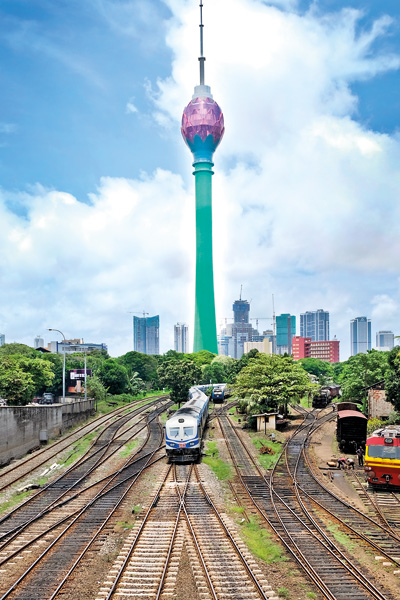News
The Lotus Tower and the missing Rs 2 billion
View(s):President Maithripala Sirisena set the cat among the pigeons last week, when he claimed that Rs 2 billion had been paid to a Chinese Company called ALIT, which could not now be located at the address given by them at the time of signing of the Agreement for the Lotus Tower (LT) Project.
The President made these revelations at the opening of the LT, touted as the tallest in South Asia, at 350 metres in height, and built at a cost of US$ 104 million, with China funding a major portion of the cost as a loan.
While details of the transaction and payments are still coming in, statements issued by various individuals and organizations, enable a sketchy picture of the whole saga to emerge. Following on the President’s speech, former President Mahinda Rajapaksa, Director General of the Telecommunication Regulatory Commission (TRC) at the time the LT Project was initiated, Anusha Pelpita, Sri Lanka’s Ambassador to Beijing Karunasena Kodituwakku, the Chinese company ALIT, have all provided some information in statements to the media. Ambassador Kodituwakku has also promised to make a further statement based on the records in the Embassy, when he returns to Beijing.
According to information available in the public domain, the contract to build the LT had been awarded in 2012 to China National Electronics Importers & Exporters Corporation (CEIEC) and Aerospace Long March International Trade Co. Ltd, (ALIT), by the Cabinet of Ministers.
The Export Import Bank of China had agreed to finance the US$ 104.3 million project (about Rs 19 billion) through a loan to be repaid in 14 years.
President Sirisena said a Rs 2 billion advance had been paid to ALIT. However, Opposition Leader Mahinda Rajapaksa stressed that, according to documents available, the Rs 2 billion advance payment had been made to CEIEC, and not to ALIT, in 2012.
He further pointed out that, the missing payment had not been included in the Auditor General’s report as well.

Lotus Tower touted as the tallest in South Asia . Pic by Amila Gamage
In a statement issued by ALIT, it states that, they formed a Consortium with CEIEC in 2010, to pursue the LT Project, and the contract was signed in 2012. ALIT further goes on to state that, in 2015, ALIT entrusted CEIEC to act solely on its behalf and fulfil its contract. The ALIT statement, however, does not either confirm or deny that it received the Rs 2 billion payment in question.
According to Ambassador Kodituwakku, President Sirisena had informed him in 2018, that letters addressed to ALIT, one of the parties to the Agreement signed in 2012, were being returned, and to have this checked out. Embassy officials found that ALIT had moved from its original address and had also withdrawn from the LT Project. Clearly, neither CEIEC or ALIT, had informed the TRC of their withdrawal, thus giving rise to this situation.
The question also arises whether one party to a tripartite Agreement could unilaterally withdraw from such an Agreement, in view of the fact that, all 3 parties would have rights and obligations under such an Agreement.
The issue of a Company, which received a payment from the Sri Lanka Government, not being found at the address given, is not unknown to the country’s investigation agencies.
In the case of the transaction between the Government of Ukraine and the Sri Lanka Government, for the purchase of MIG aircraft too, a company called Belmissa Holdings Ltd, to which the Sri Lanka Government had made payment, was found to be a fictitious company.
The controversial MiG 27 deal was first revealed by theSunday Times Defence Correspondent and Senior Journalist Iqbal Athas, in December 2006, and further exposed in The Sunday Leader by its Editor Lasantha Wickrematunge.
Interpol Headquarters had confirmed to the Financial Crimes Investigation Division that there was no company called Bellimissa Holdings Ltd in the United Kingdom. When the MiG deal fell into the media spotlight in December 2006, it was highlighted that so-called government-government deal involved payment to a mysterious third party, Bellimissa Holdings Ltd., UK. Bellimissa was, in fact, a ghost company that did not exist in any form in the UK. Even the London address it had provided to the Defence Ministry, was false.
It maybe that President Sirisena’s suspicions were aroused as a result of a similarity with the MIG deal, namely that ALIT was not found at the address given. The outcome of the MIG deal investigations remain unclear, with the investigating agencies unable to bring closure to their painstaking investigations.
Fortunately, in the case of the LT Project and the case of the Rs 2 billion payment, it may be possible to ascertain the truth much more speedily. The Parliamentary Committee on Public Enterprises (COPE) headed by Sunil Handunetti has undertaken to conduct an investigation and clarify the situation. The COPE process is quite expeditious, with their experience in investigating questionable transactions, as well as the fact that, such investigations are open to the media.
(javidyusuf@gmail.com)

